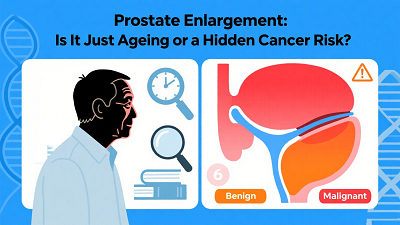Prostate Enlargement: Is It Just Ageing or a Hidden Cancer Risk?
Urinary problems such as frequent night urination, weak flow, or difficulty starting to urinate are often brushed off by men as “just getting older.” While prostate enlargement is indeed common with age, experts emphasize that these symptoms should never be ignored. Prostate issues may be benign—but in some cases, they could indicate prostate cancer.
According to Harvard Health, benign prostatic hyperplasia (BPH) is very common and does not increase the risk of prostate cancer. Similarly, Weill Cornell Medicine and Temple Health highlight that prostate enlargement does not directly cause cancer, though the two conditions can coexist. This means that while most prostate enlargement is benign, cancer should always be ruled out through proper screening.

Why Does the Prostate Enlarge?
The prostate is a walnut-sized gland located just below the bladder, surrounding the urethra. With ageing, hormonal changes—particularly involving testosterone and dihydrotestosterone (DHT)—can trigger glandular overgrowth, resulting in BPH.
However, enlargement may also occur due to:
- Benign Prostatic Hyperplasia (BPH) – the most common cause in older men.
- Prostate cancer – although not the most common cause, it can also lead to enlargement.
- Prostatitis or infection – chronic inflammation may cause swelling and urinary symptoms.
- Other urinary tract dysfunctions – including bladder weakness or neurological problems.
Common Symptoms of Prostate Enlargement
When the prostate grows, it presses against the urethra, making it harder for urine to flow. The following are typical symptoms:
Frequent urination, especially at night (nocturia)
- Weak urine stream or interrupted flow
- Hesitation before urinating
- Straining to empty the bladder
- Feeling of incomplete emptying
As Temple Health emphasizes, these symptoms are not unique to ageing—they can also indicate infection or, less commonly, prostate cancer.
Prostate Cancer: Why It’s Often Missed
Unlike breast cancer, which can be detected through self-examination, prostate cancer is hidden inside the body. Men cannot detect it on their own, making screening essential.
Healthline notes that PSA levels may rise in both BPH and cancer, which can sometimes cause confusion. This is why additional diagnostic tools—such as MRI, digital rectal exams, and biopsies—are critical in distinguishing between benign and malignant conditions.
The Importance of Screening and Early Detection
Medical experts recommend that:
- Men over 50 should undergo routine prostate screening.
- Men with a family history of prostate cancer or those of higher-risk ethnic groups (such as African ancestry) should start earlier.
Early detection can make a life-saving difference. Harvard Health highlights that localized prostate cancer can often be cured through surgery or radiotherapy. In contrast, once cancer spreads, treatment focuses only on control, not cure—bringing greater physical, emotional, and financial burden.
Managing Prostate Enlargement and Inflammation
For men diagnosed with BPH or chronic prostatitis, treatment depends on severity:
- Lifestyle measures – reducing caffeine and alcohol, maintaining a healthy weight, and regular exercise.
- Medications – alpha-blockers or 5-alpha-reductase inhibitors may be prescribed for BPH.
- Minimally invasive procedures – including laser therapy or transurethral resection (TURP).
- Traditional medicine options – For chronic prostatitis or inflammatory conditions, herbal therapies may play a role.
One such option is the Diuretic and Anti-inflammatory Pill, a natural herbal formula used in Traditional Chinese Medicine (TCM). It helps reduce inflammation, improve urinary flow, and relieve pelvic pain caused by prostatitis. Unlike conventional antibiotics, which may be less effective in chronic non-bacterial cases, this herbal therapy works by improving circulation, clearing heat, and reducing swelling—making it particularly beneficial for men with recurrent prostatitis or chronic pelvic pain.
Proactive Steps for Men’s Health
Men often overlook urinary changes or pelvic discomfort until they become disruptive. However, small and consistent daily practices can significantly reduce the risk of complications and improve overall prostate health. Here are practical, evidence-based steps men can incorporate into their daily routine:
1. Prioritize Regular Screenings
- Get checked annually after age 50, or earlier if there is a family history of prostate cancer.
- Ask your doctor about PSA tests, digital rectal exams (DRE), or MRI scans if symptoms persist.
- Remember: early detection makes treatment far simpler and more effective.
2. Maintain a Balanced Diet
- Reduce red and processed meats; studies show a high intake may increase prostate cancer risk.
- Add more vegetables and fruits, particularly those rich in antioxidants (e.g., tomatoes for lycopene, cruciferous vegetables like broccoli).
- Choose healthy fats from fish, nuts, olive oil instead of saturated fats.
- Stay hydrated, but avoid excessive caffeine and alcohol, which may worsen urinary urgency and frequency.
3. Exercise Regularly
- Aerobic activities like brisk walking, jogging, or swimming improve circulation and reduce abdominal fat, which is linked to prostate problems.
- Pelvic floor exercises (Kegels) strengthen bladder control and reduce urinary leakage.
- Aim for 150 minutes of moderate exercise per week, as recommended by global health guidelines.
4. Manage Stress and Sleep
Chronic stress may worsen urinary symptoms by tightening pelvic muscles.
Incorporate stress-relieving practices such as meditation, yoga, or deep breathing.
Ensure 7–8 hours of quality sleep per night; poor sleep can worsen nocturia (night urination).
5. Support Bladder Health
- Avoid drinking large amounts of fluid before bedtime to reduce night-time urination.
- Empty the bladder completely during each trip to avoid residual urine.
- Reduce bladder irritants like spicy foods, artificial sweeteners, and carbonated beverages if symptoms worsen after consumption.
6. Consider Complementary Therapies for Chronic Inflammation
For men dealing with chronic prostatitis or inflammation-driven urinary problems, complementary options may provide relief:
- Diuretic and Anti-inflammatory Pill – a Traditional Chinese Medicine (TCM) formula designed to clear heat, reduce swelling, improve blood circulation, and relieve pelvic pain. It can be particularly effective in men with chronic or recurrent prostatitis where conventional antibiotics are less effective.
- Herbal and lifestyle-based approaches are best used under medical supervision, complementing modern diagnostic and treatment strategies.
Conclusion
Prostate enlargement is common, but not always harmless. While most cases are due to benign growth, urinary symptoms should never be dismissed. The key is early detection: BPH can be managed effectively, and prostate cancer, if caught early, is often curable. Men who take their prostate health seriously—by combining regular screening, healthy habits, and evidence-based therapies—have the best chance of maintaining quality of life well into older age.
References
1. Harvard Health. The Growing Problem of an Enlarged Prostate Gland.
2. Weill Cornell Medicine. Enlarged Prostate or Prostate Cancer? Advances in Screening, Treatment, and Preserving Quality of Life.
3. Temple Health. Enlarged Prostate vs. Prostate Cancer.
4. Healthline. 8 Non-Cancerous Causes of High PSA Levels.
5. Wikipedia. Benign Prostatic Hyperplasia.



